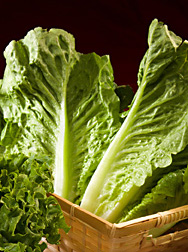This page has been archived and is being provided for reference purposes only. The page is no longer being updated, and therefore, links on the page may be invalid.
Protecting Romaine Lettuce From Pathogens
By Marcia WoodJune 27, 2008
Knowing the preferences of foodborne pathogens such as Escherichia coli O157:H7 is essential to a successful counterattack on these microbes. That's why Agricultural Research Service (ARS) microbiologist Maria T. Brandl and University of California-Berkeley colleague Ronald G. Amundson are scrutinizing the little-understood ability of E. coli O157:H7 and Salmonella enterica to contaminate romaine lettuce.
Brandl is with the ARS Produce Safety and Microbiology Research Unit, part of the agency's Western Regional Research Center in Albany, Calif.
In experiments, the scientists exposed romaine lettuce leaves to E. coli O157:H7 and found that, after 24 hours, populations of the microbe were 10 times higher on young leaves than on middle ones.
One explanation: The young leaves are a richer nutritional "hunting ground" for E. coli. They exude about three times more nitrogen and about 1.5 times more carbon than do the middle leaves, Brandl and Amundson reported.
Scientists have known for decades that plants exude compounds--from leaves and roots--that bacteria and fungi can use as food. But the romaine lettuce study, published earlier this year inApplied and Environmental Microbiology, is the first to document the different exudate levels in romaine lettuce leaves of the two age classes. It's also the first to show that E. coli can do more than simply bind to the leaves; it also can multiply.
Adding nitrogen to the middle leaves boosted E. coli growth and further pointed to a key role of nitrogen in helping this pathogen. For that reason, a strategy that decreases nitrogen fertilizer use in romaine lettuce fields may be worth investigating, Brandl noted.
According to James A. Lindsay, ARS national program leader for food safety research, commodity-specific food safety guidelines for producing and harvesting leafy greens such as lettuce have been developed. That was done through industry, government and academic collaboration, in an effort to support Good Agricultural Practices, or GAPs.
ARS is a scientific research agency of the U.S. Department of Agriculture.


